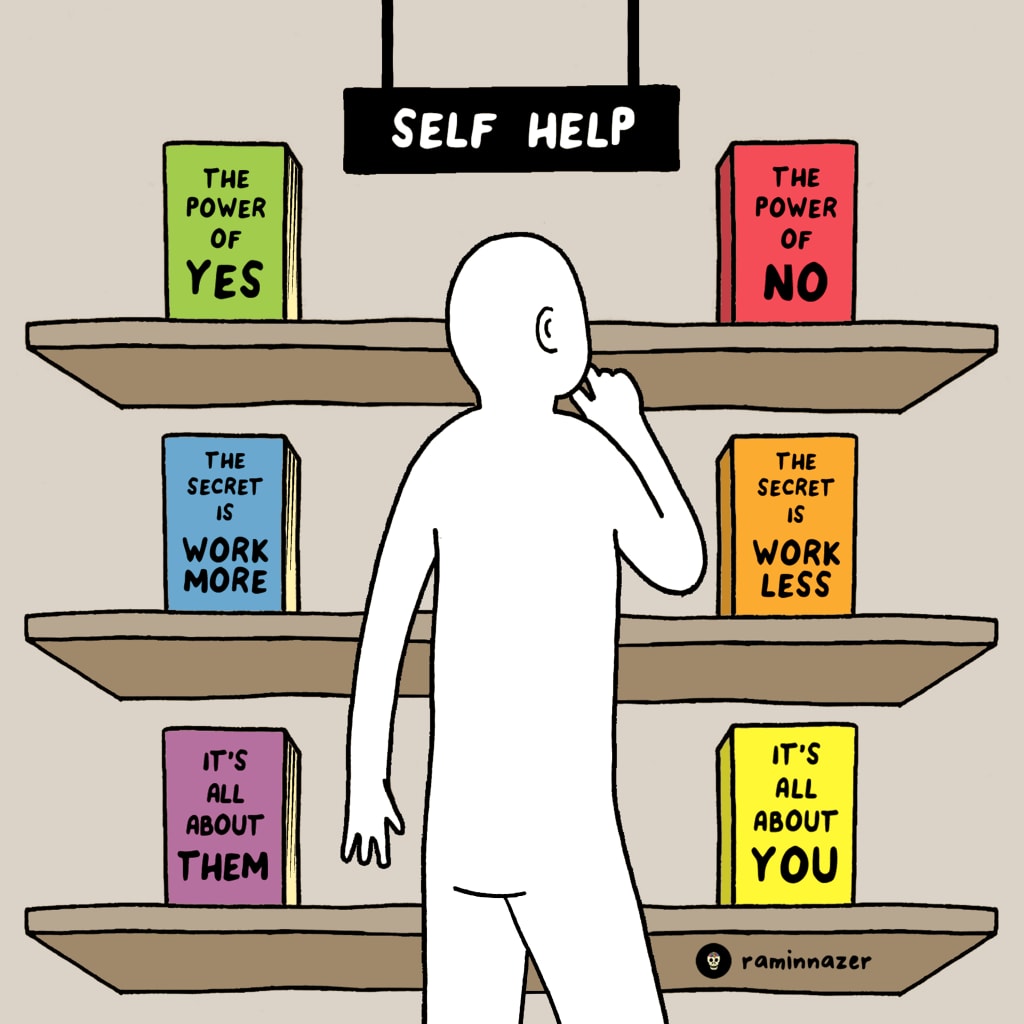Top 5 Self-Help Pet Peeves
Five red flags for useless self-help.

The Shallow Directive.
Have you considered yoga?
My first pet peeve is the habit armchair self-helpers have of offering suggestions like “you should think about taking up yoga,” or “try getting out in the sunshine more,” or “have you examined your diet recently?”
I call this “the Shallow Directive.”
Why do I hate the Shallow Directive? It’s lazy. It’s almost more of a conversational tick than sincere advice: just something that people feel obligated to say because, at that point in the conversation, something you’ve said (maybe an idle complaint, or an expression of weariness or stress) makes them feel like the rules of the conversation mandate a token gesture of positivity. They don’t expect you to take their advice, don’t care whether you do or don’t, and know you know this, and you know they know you know this. They’re socially safe in the knowledge that there’s no way for you to draw attention to the shallowness of this exchange without coming off as a jerk.
Like all self-help, the Shallow Directive is non-interactive. If you were to say, “Actually, Jeremy, I’ve already tried yoga and decided that I hate it,” Jeremy would shrug and probably be annoyed that you bothered to tell them so. Because in doing so, you’ve violated the terms of the conversation.
So if someone distractedly asks you if you’ve considered yoga, mentally file that person under “unhelpful.”
“Time out” Phraseology
Take a breath.
F**k you, self-help book. I can’t take a breath. That’s why I’m reading you.
Phrases like the following often show up in listicles: ”take a breath,” “pour yourself a glass of wine,” “give yourself some ‘me’ time each day” etc. Why do these phrases bother me? Innocuous at worst, right? Surely it’s not bad advice to take a breath, go in the other room and pour a glass of wine?
No, it’s bad advice. It sets you up to feel like a failure if it doesn’t work. It doesn’t address the problem. It doesn’t explain why it will help you.
Imagine that Ashley is full of anxiety about a certain problem in their love life. The self-help book they’re reading says, “Okay, take a breath. Give yourself some ‘me time’ today.” Although Ashley isn’t entirely sure what “me time” is supposed to mean, they carve out forty-five minutes in the evening to go to a nice restaurant alone and drink a glass of good wine. The anxiety is still there. Because anxiety doesn’t just go away when you shout “me time!” at it. Ashley now not only feels anxious; they feel like a failure. They feel like an idiot.
It boils down, like the rest of these pet peeves, to leaving out 1) the steps, and 2) the mechanism. You shouldn’t leave out the steps involved in a process no matter how simple that process may seem to you. Because it may not be so simple to the person who is actually in need of help. And you shouldn’t leave out the mechanism (i.e. how the advice actually works), because if you don’t know what that mechanism is you’re probably unqualified to be giving that advice.
So next time someone tells you to “take a breath,” do so, then say “now what, asshole?”
Lazy Infographics

Infographics dealing with concepts in wellness are pretty common. And context is everything. If you have an infographic in the employee break room that gives retail workers some reminders about how to deal with aggressive customers — something that offers concrete steps and resources — then I think that’s great. But there is a preponderance of infographics out there that offer cursory, token advice.
Consider the graphic above. The entire top half consists of the words “7 Simple Ways To Practice Self Care for Massage Therapists.” The bottom half consists of tiny print including the suggestions: “turn off your phone,” “read a book,” “drink water,” “exercise daily,” “take a deep breath,” (barf) “get a good night’s sleep,” and “Walk in nature” with blurbs that egregiously commit the “studies have shown” fallacy.
This infographic really pisses me off. It’s essentially tautological. It’s not self care. Actual self care would be telling you how to fit a walk in nature into your day, or tips for getting a good night’s sleep, or how to reduce phone-time while also running a business. The infographic touts self-care, but leaves out the actual self-care part.
I don’t think that infographics are the best way to help people help themselves. They often seem, to me, like the product of thirty minutes of a graphic designer’s time. They reek of assignment. They are best used as one tool in a greater toolkit — not as stand-alones.
Body Language BS
Your arms are crossed and you’re sitting back… you’re trying to not look like you’d rather be flirting with me.
There is a solid sub-genre of self help that promises to help you decode body language. It benefits from a “truth under your very nose” kind of rhetoric, like the one we’ll see in the next pet peeve.
But it’s complete bunk. Body language, in most cases, isn’t a decodeable language. People do things for many different reasons, and sometimes for no reason. I could have my arms crossed because I’m uncomfortable, or maybe just because I’m cold, or maybe because I’m wearing a new sweater and I like the feeling of the material. Or maybe I just noticed someone else crossing their arms and I thought they looked cool, so I’m half-consciously imitating that behavior because I want to look cool too. These books encourage confirmation bias. Confirmation bias refers to when you have a certain theory in your head and then you allow the evidence to support this theory because it appears to be confirming what you already think. For example, if you really hope someone is flirting with you, you may be prone to interpreting their uncrossed legs and arms as an “open” posture meant to invite you in. But there could be so many other reasons for such a posture. Maybe it’s warm in the room and this posture cools the person down. Or maybe they’d like to come off as merely sociable and friendly. Or maybe there’s no special reason: they just have a kind of generally slouched, open posture.
So if a book promises to help you climb the professional ladder at work by “decoding” body language, save your money. You’ll probably just end up making a false assumption about a coworker’s intention and get yourself in hot water.
New Thought and the Law of Attraction
Think positive, asshole.
From Prentice Mulford to Norman Vincent Peale to Rhonda Byrne, a century’s worth of authors have produced mega-hit publications about positive thinking and manifestation. You probably know this, but simply put the Law of Attraction states that “positive” thoughts bring positive experiences, and negative thoughts bring negative experiences. Through a kind of telepathic or even telekinetic relationship with the universe, your mere thought impacts the events in your life.
This is not just inane. It’s unhealthy.
The implication in a lot of this writing is that you have the ability to move from thinking negatively about something to positively at will. Kind of like Nike's "just do it," this kind of self-help manifests as, essentially, pep-talk. The simplicity of the message is a large part of its rhetorical force. Rhonda Byrne’s The Secret: ““If you are feeling good , it is because you are thinking good thoughts.”
Proponents of the Law of Attraction will tell you of times in their lives when they’ve “manifested” something by positively envisioning it. But the Law of Attraction is a swamp of confirmation bias, post hoc fallacy, and self-fulfilling prophecy that can easily dupe someone who is facing a real, desperate need for change into thinking that manifestation is actually at work.
Meet Eric. Eric just can’t score a date. This bums Eric out, and Eric starts thinking that he’ll never be able to score a date. Eric then decides to follow the Law of Attraction and begins constantly telling himself, “On Monday of next week, I’m going to score a date.” Then Monday comes. Eric goes to a coffee shop. You know where this is going…
Later, he’ll describe it like this: “And just as I envisioned, into the coffee shop walks the most beautiful girl I’ve ever seen. I went right up to her and introduced myself and eventually got a coffee date for next week. The Law of Attraction worked! You can’t tell me it didn’t!”
First, this is called a self-fulfilling prophecy. Which means that it was always within Eric’s own power to meet a prospective mate, therefore to fulfill the prophecy he finds someone at a coffee shop and subconsciously assigns her the characteristics the prophecy said she was supposed to have. Next, it is a simple post hoc fallacy. “Post hoc ergo propter hoc” is Latin for “after this, therefore because of this.” A happened, then B happened; therefore A caused B. This is one of the most common fallacies, and it’s easy to miss if you aren’t looking out for it. A may very well have caused B, but in a post hoc fallacy you’re simply assuming that it must have, simply because of the order of events. You should be doing the work of explaining how A cause B.
And you’ll protest, “But wait. Whether or not it’s a self fulfilling prophecy, it came true! Eric got a date.” My response: Eric got a date this time. But a week later, the girl tells Eric that she just wants to be friends. The next three times he tries it, Eric gets no dates. He keeps trying to think positive thoughts, denying and ignoring the fact that he is experiencing pain and loneliness.
Yeah, manifestation is great… the statistically few times that the cold, unfeeling, will-lacking Universe happens to accord with your will.
Just to give you a quick idea of the reach of these ideas, the following is from the Mayo Clinic’s website, from the web page on “Resiliency Training.”
“You can develop resilience by learning to train your attention on more-positive aspects of your life. You use purposeful, trained attention to decrease negative thoughts in your mind and bring greater focus on the most meaningful aspect of an experience.”
In other words: ignore the pain!
Who wrote this garbage? The web page is maybe two hundred words long. It directs you nowhere. It propounds the old lie that ignoring the negative thoughts and focusing exclusively on the positive is a healthy thing to do. And if I had more time, I could get into the fact that the entire philosophy is based on a false dichotomy between “bad” and “good.”
It’s absolutely dejecting that an institution as highly-regarded as the Mayo Clinic would perpetrate such bullshit. But that’s the pervasiveness of bunk self help. And it makes sense. A drowning person reaches out for anything that looks like a hand. And there are people out there who make a lot of money selling hands to the drowning.

About the Creator
Eric Dovigi
I am a writer and musician living in Arizona. I write about weird specific emotions I feel. I didn't like high school. I eat out too much. I stand 5'11" in basketball shoes.
Twitter: @DovigiEric






Comments
There are no comments for this story
Be the first to respond and start the conversation.